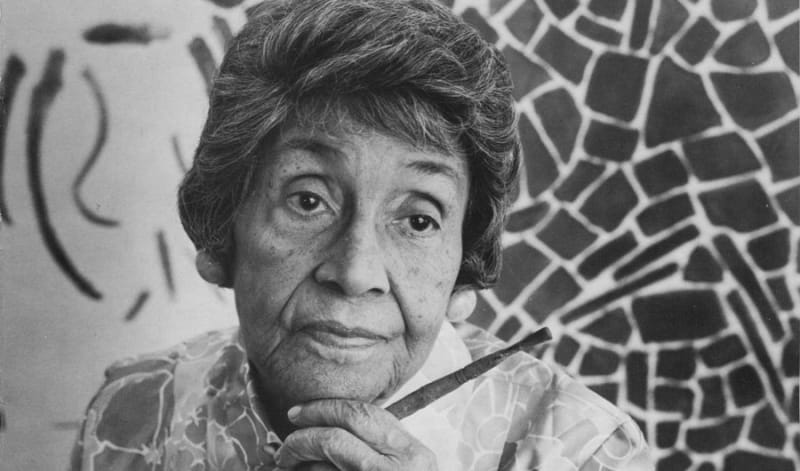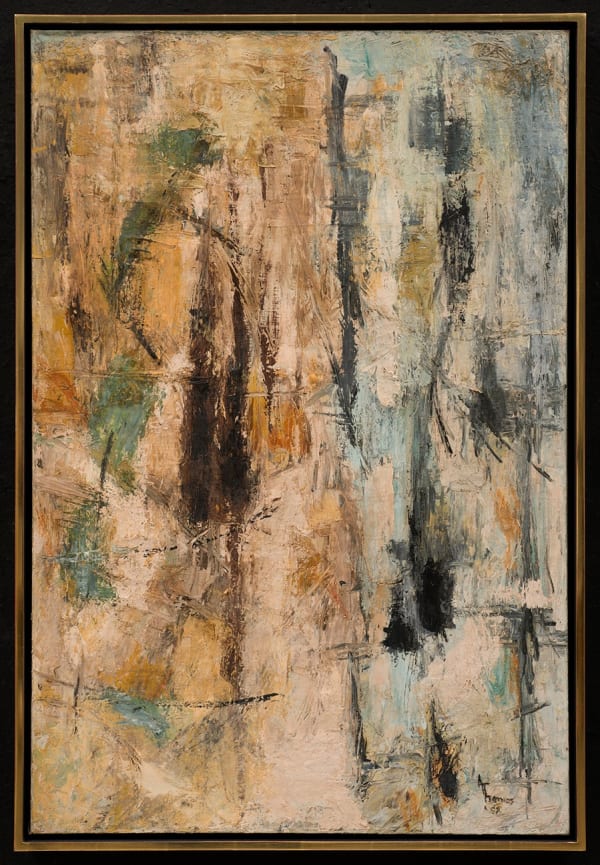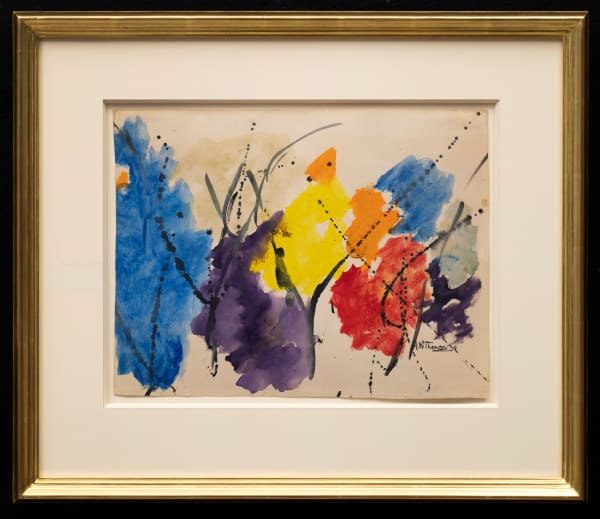Alma Woodsey Thomas US, 1891-1978
“Man’s highest inspirations come from nature. A world without color would seem dead. Color is life. Light is the mother of color. Light reveals to us the spirit and living soul of the world through colors.”
- Alma Woodsey Thomas
Born in Columbus, Georgia Alma Woodsey Thomas was the eldest of four daughters. Her father, John Harris Thomas was a businessman, and her mother, Amelia Cantey Thomas, was a teacher. The Thomas family moved from Georgia to Washington, D.C. in 1907 in an effort to escape racial tensions and to seek better educational opportunities for the family.
Thomas was able to attend a high school in Washington, D. C. that offered art classes. She said, “When I entered the art room, it was like entering heaven.” At Armstrong Technical High School she became known for her interest in architecture and excelled in mathematics and science. After graduating from high school, she continued her education in Washington, D. C. where she enrolled at the Miner Teachers Normal School. At Miner, she continued to spend time in the art room and to “make things.” After graduation, Thomas took a position in Wilmington, Delaware at the Thomas Garrett Settlement House, where for six years she taught general arts and crafts to the younger children.
In 1921, Thomas returned to Washington, D. C. to attend Howard University. She moved back into the family residence on Fifteenth Street; that was to remain her permanent residence until her death in 1978. As a university student, she enrolled in the home economics department to major in costume design. Her first year at Howard, she met James V. Herring, a professor at the university, who was struggling to create a department of fine arts. Herring persuaded Thomas to become the first student to enroll in the fine arts curriculum.
Thomas graduated from Howard University in 1924 with the school’s first degree in fine arts. After graduating with a Bachelor of Science degree in fine arts, she accepted a position as art teacher at Shaw Junior High School where she remained until her retirement. Thomas supplemented her teaching career by attending classes at Columbia University during the summers in the 1930s and at American University in the 1950s.
In 1950, ten years before her retirement, Thomas enrolled at American University to study painting and art history. She began her formal study of art as a representational painter. Influenced by Joe Summerford, Robert Gates, and Jacob Kainen, all of whom taught at American University during the 1950s, Thomas steadily moved toward a more abstract idiom during this period of her life. Thomas also worked through the influence of Cubism and Abstract Expressionism until she achieved success with unique canvases exploring color, nature, and abstraction.
After she retired in 1960, Thomas dedicated her energies full time to what she herself termed “serious painting.” Now almost 70 years old, but gaining in confidence, she began to produce paintings more gloriously colored than ever before. In her search for personal expression during the early 1960s, she painted many watercolors, finding in this medium a freshness and spontaneity that matched her dynamism. The lightness of watercolor paint-its pure, bright colors, can be seen in the small works she painted during this period. Thomas sometimes produced as many as 20 watercolor studies before committing herself to a painting on canvas.
Thomas held her first solo exhibition in Washington, D. C. at the Dupont Theatre Art Gallery on Connecticut Avenue in 1960. The show, which consisted mostly of abstract watercolors, was an unqualified success and all but one of the 25 works sold.
In 1966, James Porter, director of the Gallery of Art at Howard University, invited Thomas to assemble a retrospective of her work. She treated this invitation as an opportunity to create something new. Thomas decided to “produce something significantly different, something different from anything I’d ever seen, different from anything I’d ever done.” Thomas challenged herself to create new works and the results of this challenge were the series of works called “Earth Paintings” that treated wind and flower subjects.
Stirred by the “leaves and flowers tossing in the winds as though they were dancing and singing,” she turned to fluid acrylic color to help her dissect, enlarge, and round her patterns. The titles she gave to the “Earth Paintings” series, such as Alma’s Flower Garden, Spring Flowers Near Jefferson Memorial, and Azaleas Spring Display, relate them to nature, although the paintings depart entirely from nature’s forms. With this series, she developed a specific method of interpretation, a unique visual language.
Throughout her career, Thomas experimented with a variety of artistic styles. She achieved national recognition in 1972 when she had a one-person exhibition at the Whitney Museum of American Art, a first for an African American woman. Thomas was Black, a woman, and an artist. Each of these circumstances presented its own difficulties but she was persistent and committed to overcoming these barriers and made the choices necessary to adapt her life to the education of her vision. Thomas did not paint black subjects and did not address racial or feminists’ issues in her works. She believed the creative spirit to be independent of race or gender.
Perhaps for this reason, Thomas is as closely associated with the Color Field artists such as Kenneth Noland, Jules Olitski, Helen Frankenthaler, etc. and the second generation of abstract expressionism, as she is with African American art.
Thomas wrote: “Creative art is for all time and is therefore independent of time. It is of all ages, of every land, and if by this we mean the creative spirit in man which produces a picture or a statue is common to the whole civilized world, independent of age, race and nationality, the statement may stand unchallenged.” Thomas spent her entire life of almost 90 years observing the world and communicating what she saw to others. Her vision of the world was tied to her career of teaching art to children and her appreciation of her flower garden as well as to the production of grand and joyous paintings of abstract color.
-
 Alma Woodsey ThomasRed with a Touch of Orange, 1973
Alma Woodsey ThomasRed with a Touch of Orange, 1973 -
 Alma Woodsey ThomasUntitled, 1958
Alma Woodsey ThomasUntitled, 1958 -
 Alma Woodsey ThomasFlash of Autumn, 1968
Alma Woodsey ThomasFlash of Autumn, 1968 -
 Alma Woodsey Thomas"Fallen Wings", 1967
Alma Woodsey Thomas"Fallen Wings", 1967 -
 Alma Woodsey Thomas"Raspberry", circa 1972
Alma Woodsey Thomas"Raspberry", circa 1972 -
 Alma Woodsey ThomasUntitled, circa 1968
Alma Woodsey ThomasUntitled, circa 1968 -
 Alma Woodsey ThomasBlue Opus II, 1962
Alma Woodsey ThomasBlue Opus II, 1962 -
 Alma Woodsey ThomasShells & Fruit, 1956
Alma Woodsey ThomasShells & Fruit, 1956 -
 Alma Woodsey ThomasUntitled, 1967
Alma Woodsey ThomasUntitled, 1967 -
 Alma Woodsey ThomasMy Fall Garden, circa 1969
Alma Woodsey ThomasMy Fall Garden, circa 1969 -
 Alma Woodsey ThomasUntitled, circa 1960
Alma Woodsey ThomasUntitled, circa 1960 -
 Alma Woodsey Thomas"Snoopy Gets a Glance at Mars", 1969
Alma Woodsey Thomas"Snoopy Gets a Glance at Mars", 1969 -
 Alma Woodsey Thomas"Atmospheric Effect No. 6", 1972
Alma Woodsey Thomas"Atmospheric Effect No. 6", 1972 -
 Alma Woodsey ThomasPale Yellow Autumn Leaves, 1977
Alma Woodsey ThomasPale Yellow Autumn Leaves, 1977 -
 Alma Woodsey ThomasWind Dances in Flower Garden, 1968
Alma Woodsey ThomasWind Dances in Flower Garden, 1968 -
 Alma Woodsey ThomasAlma's Flower Garden, 1968-70
Alma Woodsey ThomasAlma's Flower Garden, 1968-70 -
 Alma Woodsey ThomasLunar Rendezvous – Circle of Flowers, 1969
Alma Woodsey ThomasLunar Rendezvous – Circle of Flowers, 1969 -
 Alma Woodsey ThomasEtude, 1968
Alma Woodsey ThomasEtude, 1968



















